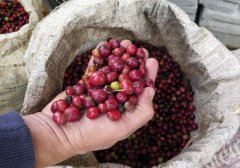Description of the flavor and aroma of coffee beans washed by hummingbirds at the San Ruman treatment Plant in Costa Rica

For professional baristas, please follow the coffee workshop (Wechat official account cafe_style)
Coffee producing area: Tarrazu
Coffee variety: Caturra.Catuai
Annual rainfall: 2000 mm
Grading standard: SHB
Average annual temperature: 19 degrees C
Treatment method: washing method
Raw bean specification: 17-18 mesh
Planting altitude: 1700m
Type of soil: volcanic soil
Water washing of hummingbird in San Ruman treatment Plant, Costa Rica
Most of the best coffee in Costa Rica seems to come from small processing plants.
Spread throughout several major coffee producing areas
Including Tarazhu and the western valley. This so-called coffee revolution originated 15 years ago.
It has greatly changed the views of bean baking experts and importers on Costa Rican coffee.
Take the processing plant as the center, collect coffee beans from the surrounding small farms for processing.
Most of these farms are composed of small communities or families.
Grow coffee on one's own small farm or land
The coffee is all processed and dried by a small processing plant.
St. Roman treatment plant, mainly using water washing treatment.
It is famous for its strong, rich and solid coffee.
Coffee cherries are hand-selected.
Overripe or immature cherries are removed by coffee farmers before production treatment
Use a 3 disc Aagarrde peeling machine to remove the peel and pulp
Then use the machine to divide it into three grades according to the density of coffee beans.
Raw beans of grades 1 and 2 are fermented separately.
Grade 3 is a low-quality raw bean.
The raw beans were fermented in the shade for about 24 to 36 hours.
Wash the raw beans after fermentation and grade them again according to the density on the cleaning channel.
Then soak the raw beans in water at random for the night.
Flavor description:
Aromas of tea, sweet candy, grape, caramel, cream, subtle spices
The flavor of bitter sweet chocolate is as thick and sweet as cream candy.
*
Everyone's taste is not necessarily what they like.
You can consider buying a small amount and trying different baking degrees.
Soy beans in an explosion
Drop the beans at the end of the explosion.
Drop the beans from the end of the first explosion to the second explosion.
Touch the beans under the second explosion.
Put the beans into the second explosion for 10-15 seconds
The second explosion of dense beans
I hope you bakers can find a more favorite flavor.
*
There's something I need to explain to you.
Coffee beans are agricultural products.
Will vary a little from year to year due to climate change.
If you feel a little different, please forgive me!
Consider other coffee beans next time.
*
The greener the appearance of raw beans, the more moisture.
During the baking process, if the temperature drops too low during an explosion, it may not be cooked enough.
It is recommended to reduce moisture before baking (can be insolated for a few days or use a dehumidifier)
The more whitening parts, the less moisture.
*
Some coffee beans are emerald green and have more flavor after baking.
Some are whitening and taste better after baking.
There are many skills in the baking process.
The same degree of baking but different curves of time and temperature
The taste is also slightly different, and everyone's favorite flavor is not necessarily.
Important Notice :
前街咖啡 FrontStreet Coffee has moved to new addredd:
FrontStreet Coffee Address: 315,Donghua East Road,GuangZhou
Tel:020 38364473
- Prev

Boutique coffee bean flavor, taste and aroma description of Bouyenos Aires, the champion estate of elephant beans in Nicaragua
For the exchange of professional baristas, please follow the coffee workshop (Wechat official account cafe_style) 65 Central American varieties: Maragogype Giant Elephant Bean owner: Luis Emilio Valladarez Zelaya producing area: Nueva Segovia City: Dipilto Grade: Strictly Hard Beans (S.H.B. EP) strict selection of high altitude very hard beans AA PREMIUM SPECIALTY
- Next

Suntanned Soul of La La Haas Manor in Costa Rica Flavor Coffee Bean Flavor and Taste description
For the exchange of professional baristas, please follow the coffee workshop (official Wechat account cafe_style) Las Lajas Estate Alma Negra country: Costa Rica name: la Lajas Manor Black Soul producing area: central Valley Grade: SHB treatment method: sun altitude Rice varieties: Caturra Catuai Flavor description: Bordeaux honey, pineapple, cider vinegar, wine-soaked cherry
Related
- Detailed explanation of Jadeite planting Land in Panamanian Jadeite Manor introduction to the grading system of Jadeite competitive bidding, Red bid, Green bid and Rose Summer
- Story of Coffee planting in Brenka region of Costa Rica Stonehenge Manor anaerobic heavy honey treatment of flavor mouth
- What's on the barrel of Blue Mountain Coffee beans?
- Can American coffee also pull flowers? How to use hot American style to pull out a good-looking pattern?
- Can you make a cold extract with coffee beans? What is the right proportion for cold-extracted coffee formula?
- Indonesian PWN Gold Mandrine Coffee Origin Features Flavor How to Chong? Mandolin coffee is American.
- A brief introduction to the flavor characteristics of Brazilian yellow bourbon coffee beans
- What is the effect of different water quality on the flavor of cold-extracted coffee? What kind of water is best for brewing coffee?
- Why do you think of Rose Summer whenever you mention Panamanian coffee?
- Introduction to the characteristics of authentic blue mountain coffee bean producing areas? What is the CIB Coffee Authority in Jamaica?

